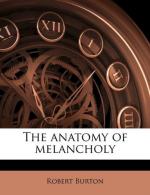SUBSECT. III.—Concerning Physic.
Physic itself in the last place is to be considered; “for the Lord hath created medicines of the earth, and he that is wise will not abhor them.” Ecclus. xxxviii. 4. ver. 7.[0000] “of such doth the apothecary make a confection,” &c. Of these medicines there be diverse and infinite kinds, plants, metals, animals, &c., and those of several natures, some good for one, hurtful to another: some noxious in themselves, corrected by art, very wholesome and good, simples, mixed, &c., and therefore left to be managed by discreet and skilful physicians, and thence applied to man’s use. To this purpose they have invented method, and several rules of art, to put these remedies in order, for their particular ends. Physic (as Hippocrates defines it) is nought else but [2882]"addition and subtraction;” and as it is required in all other diseases, so in this of melancholy it ought to be most accurate, it being (as [2883]Mercurialis acknowledgeth) so common an affection in these our times, and therefore fit to be understood. Several prescripts and methods I find in several men, some take upon them to cure all maladies with one medicine, severally applied, as that panacea, aurum potabile, so much controverted in these days, herba solis, &c. Paracelsus reduceth all diseases to four principal heads, to whom Severinus, Ravelascus, Leo Suavius, and others adhere and imitate: those are leprosy, gout, dropsy, falling-sickness. To which they reduce the rest; as to leprosy, ulcers, itches, furfurs, scabs, &c. To gout, stone, colic, toothache, headache, &c. To dropsy, agues, jaundice, cachexia, &c. To the falling-sickness, belong palsy, vertigo, cramps, convulsions, incubus, apoplexy, &c. [2884]"If any of these four principal be cured” (saith Ravelascus) “all the inferior are cured,” and the same remedies commonly serve: but this is too general, and




